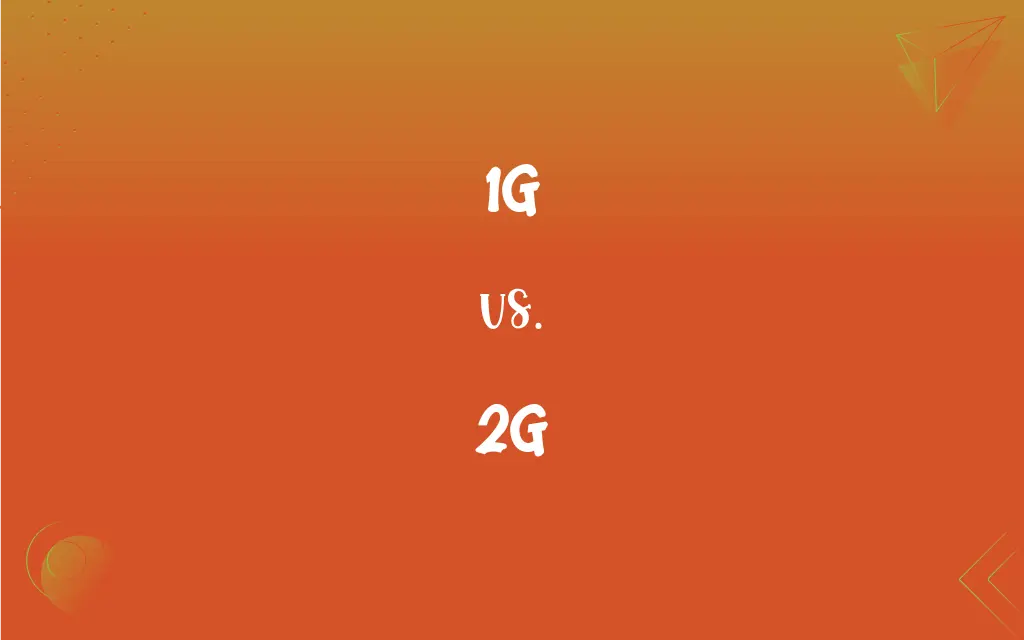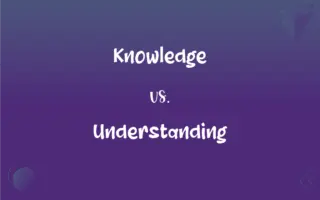1G vs. 2G: What's the Difference?
Edited by Aimie Carlson || By Harlon Moss || Updated on October 23, 2023
1G represents the first generation of wireless cellular technology, offering voice-only communication, while 2G, the second generation, introduced digital technology and text messaging.

Key Differences
1G, which stands for the first generation, marks the inception of wireless cellular technology. This generation relied on analog technology and primarily facilitated voice-only communication. These early mobile systems were groundbreaking for their time, laying the foundational groundwork for mobile communication and allowing users to make calls without being tethered to landlines.
2G, or the second generation, represents a significant leap from its predecessor. The most notable distinction is that 2G transitioned from analog to digital technology. This shift not only improved voice quality but also enhanced security, reducing the risk of calls being intercepted. Moreover, it laid the groundwork for more advanced cellular services and data transfer.
A revolutionary feature introduced with 2G was the capability to send and receive text messages, known as SMS (Short Message Service). This feature, while rudimentary by today's standards, was a major advancement during its era, offering an alternative mode of communication aside from voice calls. Consequently, 2G's arrival began shaping the way people communicated, setting a precedent for future cellular innovations.
Furthermore, 1G systems operated on varying frequencies depending on the region, leading to compatibility issues across networks and countries. In contrast, 2G started the journey towards standardizing frequencies and protocols, making international roaming feasible. Battery life also witnessed improvement in 2G phones, given the technology's efficiency.
To summarize, while both 1G and 2G played pivotal roles in the evolution of mobile communication, they differ substantially. 1G ushered in the era of mobile telephony with analog voice calls, whereas 2G elevated the experience, introducing digital technology, text messaging, and laying the groundwork for modern cellular systems.
ADVERTISEMENT
Comparison Chart
Technology
Analog
Digital
Primary Service
Voice-only communication
Voice and SMS
Security
Basic; calls could be intercepted
Enhanced with digital encryption
Standardization
Varying frequencies based on region; compatibility issues
Move towards standardized frequencies; facilitated international roaming
Battery Efficiency
Less efficient due to analog technology
More efficient owing to digital tech
ADVERTISEMENT
1G and 2G Definitions
1G
The earliest stage in the evolution of cellular telephony.
1G set the stage for more advanced and versatile mobile technologies.
2G
Cellular systems that started the journey towards international roaming.
With 2G, travelers began experiencing fewer connectivity issues while abroad.
1G
Wireless systems that laid the groundwork for mobile communication.
Even with its limitations, 1G was a milestone, liberating users from fixed phone lines.
2G
Mobile networks that brought the Short Message Service (SMS) into existence.
Text messaging became a popular form of communication with the advent of 2G.
1G
Mobile networks that operated on differing frequencies depending on location.
The lack of standardization in 1G led to compatibility issues across countries.
2G
A pivotal step in mobile tech evolution, bridging the gap between analog and digital.
The transition from 1G to 2G set the stage for subsequent innovations in mobile technology.
1G
The first generation of mobile cellular systems using analog technology.
The introduction of 1G in the 1980s revolutionized communication by enabling mobile voice calls.
2G
Digital networks with enhanced security compared to their analog predecessors.
The digital nature of 2G made eavesdropping more challenging, ensuring better call privacy.
1G
A foundational phase in wireless communication that primarily supported voice.
Unlike later generations, 1G did not support data or texting services.
2G
The second generation of cellular technology that introduced digital transmission.
2G networks marked a significant improvement over 1G, offering clearer voice calls.
FAQs
Were 1G calls secure?
1G had basic security, making calls susceptible to interception.
Is 2G analog or digital?
2G is digital.
What major feature did 2G introduce?
2G introduced text messaging or SMS.
How did 2G affect the mobile industry?
2G paved the way for more sophisticated mobile services and set the foundation for future cellular tech advancements.
Did 1G support text messaging?
No, 1G primarily supported voice-only communication.
Did 2G improve battery life?
Yes, 2G phones generally had better battery efficiency compared to 1G.
Were 1G and 2G networks operational simultaneously?
Yes, for a period, both networks coexisted before 1G was phased out.
Why was the transition from 1G to 2G significant?
The shift from analog (1G) to digital (2G) brought clearer calls, texting, and enhanced security.
Could 2G phones access the internet?
2G introduced basic internet capabilities but was much slower than subsequent generations.
What came after 2G?
After 2G came 3G, which introduced faster data speeds and multimedia capabilities.
Were 1G phones bulky?
Yes, initial 1G phones were relatively large and heavy.
Why did we move from 1G to 2G?
The transition catered to the need for clearer voice quality, enhanced security, and additional features like texting.
Did 2G phones support apps?
2G phones had very basic applications, but the concept of app stores and extensive apps came later with 3G and 4G.
What led to the decline of 2G?
The introduction of 3G with faster data speeds and multimedia features led to the gradual phasing out of 2G.
Could 1G phones send pictures or videos?
No, 1G supported voice calls only.
Was international roaming possible with 1G?
1G had varied frequencies by region, leading to roaming challenges.
What does 1G stand for?
1G stands for the first generation of wireless cellular technology.
What was the primary mode of communication in 2G?
Voice calls and SMS were the main forms of communication in 2G.
Did 2G phones have cameras?
While 2G introduced some basic features, cameras became more common with 3G.
When was 1G first introduced?
1G was introduced in the early 1980s.
About Author
Written by
Harlon MossHarlon is a seasoned quality moderator and accomplished content writer for Difference Wiki. An alumnus of the prestigious University of California, he earned his degree in Computer Science. Leveraging his academic background, Harlon brings a meticulous and informed perspective to his work, ensuring content accuracy and excellence.
Edited by
Aimie CarlsonAimie Carlson, holding a master's degree in English literature, is a fervent English language enthusiast. She lends her writing talents to Difference Wiki, a prominent website that specializes in comparisons, offering readers insightful analyses that both captivate and inform.































































